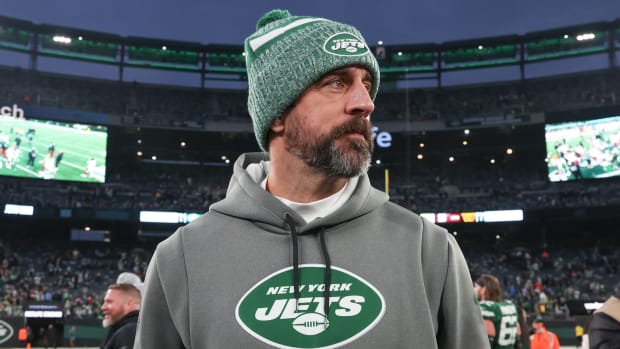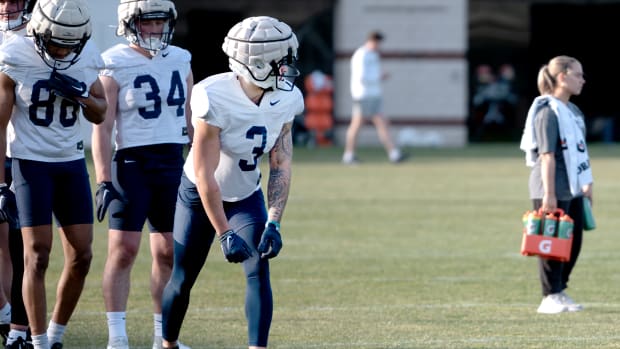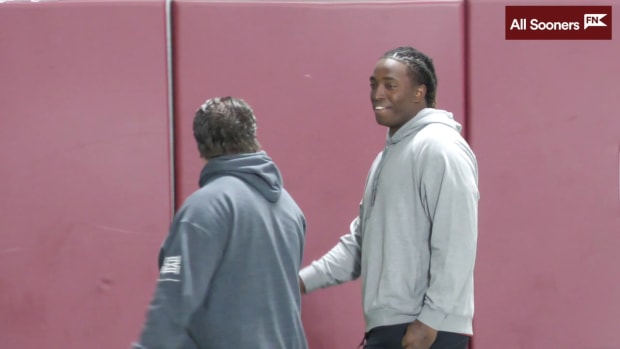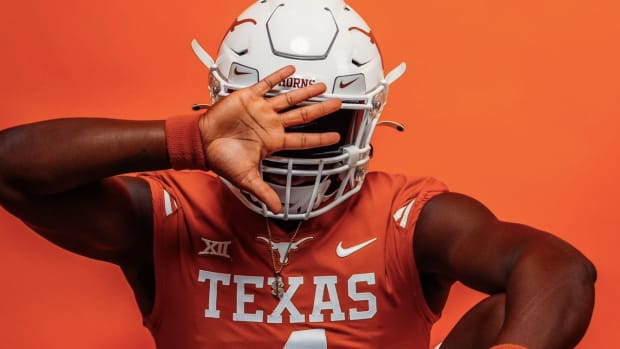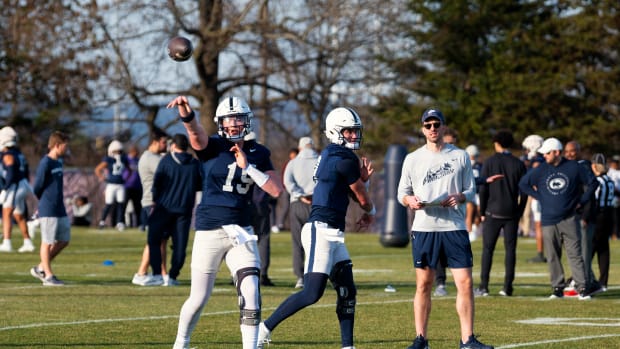'We’re Definitely Heading the Wrong Way': As Virus Cases Spike, Hurdles to a College Football Season Mount
In the heart of the coronavirus pandemic shutdown, the economy closed and sports stalled, a depressive time with scant optimism, Doug Aukerman, of all people, oozed confidence. As a longtime athletics physician and hospital clinician, Aukerman saw enough progress in the United States to have increased hope for a 2020 college football season. Cases were receding. Deaths were declining. Hospitalizations were dipping.
Then in May, states began to slowly open their economies, and universities announced on-campus classes in the fall. June gave way to more good news. College campuses welcomed back their athletes for voluntary training, and NCAA leaders created a new six-week preseason practice plan.
The optimism over an on-time kickoff, though, came with a caveat from administrators and doctors alike. A spike in virus cases, they warned, could derail the forward progress. “Now,” says Aukerman, “we’re definitely heading the wrong way.”
A month from the scheduled start of preseason camp, a rash of viral cases is sweeping across the country. Schools are pausing summer workouts. States are suspending reopening plans. Hospitals, once clear of COVID-19 patients, are again inundated with the infected.
BARNHART: Will We Play Football in 2020? The Latest Signs Don't Look Good
College athletic leaders are having serious doubts on an on-time start to the 2020 college football season, or if a fall season is even possible at all. Feelings of optimism and confidence have turned to hope and apprehension. Contingency plans, dismissed weeks ago, are back in the proverbial picture, such as delaying the season deeper into the fall or moving it into the spring. And while a month remains before a decision deadline—NCAA leaders are targeting the first week of August—despair looms over a sport that just 15 days ago appeared to avoid the most catastrophic outcome: no fall football.
“Until two weeks ago, everybody felt pretty good about starting on time on Sept. 5 and Aug. 29,” says West Virginia athletic director Shane Lyons, the chair of an important law-making NCAA body, the Football Oversight Committee. “The last two weeks have really put a wet blanket on that, and we’re saying, ‘Maybe that’s not going to happen.’”
College athletic executives enter what many believe is the most crucial month in the modern history of the sport. At the end of which, they must determine whether—during a global pandemic—to promote a collision-filled sport that involves more than 100 locations and 10,000 young people. What decides such an outcome is actually quite simple: Viral cases must fall or at the very least plateau, college administrators and NCAA medical experts told Sports Illustrated this week.
One described it succinctly: “It’s going to take a pretty dramatic change.”
Confirmed cases are on the rise in at least 41 of the 50 states, according to information from the Associated Press, and the percentage of tests returning positives are increasing in 39 of them. The nation’s most populous states have been hit hard. Florida set a record single-day high of 11,400 cases over the weekend, and in California, hospitalizations are up 56% in the past two weeks. Texas, as recently as Tuesday, shattered single-day records for virus-related deaths and hospitalizations. Twenty-six FBS programs, or one-fifth of all major college football teams, reside in those three states.
The sport’s own power brokers, from Alabama coach Nick Saban to Texas athletic director Chris Del Conte, are concerned enough that they’ve developed into COVID-19 public health advocates. Administrators and coaches are captaining the sport’s wear-a-mask movement, spearheading the campaign to social distance and leading the charge to wash hands. If you want football, they’ve said, follow these guidelines.
Even politicians are getting involved. South Carolina Gov. Henry McMaster said last week that he won’t allow college or high school football this fall if cases in the state continue to rise.
Missing a season could have cataclysmic and long-reaching effects for the billion-dollar industry of college football. Athletic departments, many of which only break even, often lean heavily on football revenue to make ends meet. At the highest level, television money, ticket sales and football donations keep afloat programs. Smaller departments, meanwhile, rely on state and institution support, such as student fees, which are also adversely impacted in this economic climate.
“We're so dependent on football revenue,” says one Power 5 athletic director, “if we don't have a season we're all in trouble.”
Some believe the situation isn’t as dire as others. The contrast can be sharp. The most hopeful athletic directors believe the chance to start on time—seven weeks from this weekend—is still at 80-90%. Those more pessimistic give it a one in three shot. A slew of news Wednesday didn’t help. North Carolina and Ohio State both paused workouts because of positive tests, and the Ivy League became the first Division I conference to suspend its football season.
“Two or three weeks ago, I was cautiously optimistic that if things kept going well, we’d be able to start on time and play a full season,” says Larry Scott, the Pac-12 commissioner. “But things haven’t gone as well.”
Administrators are questioning their own colleagues, in fact. Some wonder aloud why the season hasn’t yet been delayed or moved to the spring. “I hope we're not selling our souls to the devil to try to play,” says another athletic director on the Power 5 level.
One Power 5 AD hoped to draw optimism from the return of professional leagues. Instead, both the NBA and MLB, now only practicing, have endured outbreaks despite a more restrictive situation—“bubble”—than colleges could ever create. “The challenges,” the administrator says, “are mounting.”
Are college athletic leaders just kicking the can down the road to an inevitable end? “Unfortunately,” says one AD, “there is a semi-truck barreling down the road that is about to crush the can and its owners.”
SEC commissioner Greg Sankey acknowledged the issues last week in an interview with SI, describing the situation as uncomfortable. Even medical experts on the NCAA’s own COVID-19 Advisory Panel are questioning an on-time start. “If hospitals are in trouble in places, it becomes harder,” says Amesh Adalja, a senior scholar at John Hopkins University and an infectious disease physician. “You think, ‘Should you be playing football when your hospitals are inundated?’”
Big 12 commissioner Bob Bowlsby describes the latest spikes as “detrimental” to the process, while also still gripping onto optimism. “I don’t think it’s panic time,” he says. In weekly calls with athletic physicians, the five Power 5 conference commissioners, the most powerful decision-makers in the sport, haven’t yet been told to shut down. Doctors have told administrators that outbreaks were expected, Bowlsby says. They’ve said testing advancements and mitigation procedures continue to make strides, as society is adapting to co-exist with the virus.
Viral spikes are mostly localized, physicians say, with hot spots in varying parts of a state or county, while others are seeing little to no rise. For example, Aukerman, Oregon State’s team doctor, has recorded no positive tests since Beavers athletes returned to campus. Meanwhile, places like Clemson, North Carolina, Texas and Texas Tech have exceeded a combined 90 positives.
“I’m still relatively optimistic, and a lot of it is because of the calls I’m a part of,” says Todd Berry, the executive director of the American Football Coaches Association who sits on the NCAA Football Oversight Committee and is involved in conference calls with NCAA physicians. “I’m not surprised at where we’re at. That’s what we were told. I think there’s some pretty upbeat news in relation to treatments and testing and accuracy of tests and the cost of the tests.”
Officials are hopeful enough that the Oversight Committee is continuing deliberations as if a fall season will unfold, while also employing a working group for the possibility of using contingency plans that have long been vetted and discussed. The three primary plans include (1) delaying the season deeper into the fall, with a cut-off point of mid-October; (2) playing an abbreviated season of only conference games that would likely begin later than Labor Day; and (3) move the season to the spring.
Each plan presents problems. Any delay may dramatically reshuffle schedules and push the season deeper into the traditional winter months of flu season. A conference-only schedule could pose problems for independents, like Notre Dame and BYU, and would cost Group of Five programs millions of dollars in the loss of guarantee games with Power 5 schools.
And the spring? Scott called it a “fallback” plan, and many other officials think of it as a last resort, as it poses dozens of problems. College stars may snub the season for the NFL draft, football will clash with other on-campus spring sports and the 2020 offseason would shrink by five months.
There is also an inherent gamble in the move. Officials would be betting that conditions for playing will be better then. Sankey cautions in making such a critical decision based on predictions of a novel virus. “You have to think about, ‘What will you know in January that will be different?’” Sankey says. “It’s been difficult to predict.”
While doctors can guarantee strides in medical technology and testing advancement by next year, no one can predict the disease’s evolution, Aukerman says. But when given the choice of no season or a spring season, “Why in the heck would you not play in the spring?” asks one Group of Five athletic director. If there is a spring season, one P5 AD anticipates that it will not be a full 12-game schedule but would be six to nine games.
Bowlsby calls a spring season a “viable option” but notes another challenge it could pose. The season would likely run from March through May, he says, meaning preseason practice would begin the last week of January. “You’re now teeing it up right in the middle of the flu/virus/cold season,” he says. “It sort of feels like leaning into a left hook.”
While an exact date isn’t set to make a decision, commissioners agree that the start of preseason camp—the first week of August—would be a natural time to re-examine things. “Time is starting to catch up to us,” says Lyons. “Tough decisions are going to have to be made. Are we going to kick off Sept. 5, delay it, or worse case scenario, not play at all?”
Above anything else, the decision may ultimately be rooted in optics. The campus outbreaks in June are only small brush strokes in a much larger portrait. Each new positive case in the U.S.—each new hospitalization and each new death—further complicates college football’s plight. As cases rise, local public health departments—some potentially in a university’s backyard—become stressed. Testing becomes more necessary for those sick and potentially symptomatic individuals.
Testing scarcity and overwhelmed hospitals will be the “death knell” in a 2020 college football season, one team physician told SI. On a recent call with the White House virus task force, Bowlsby says the topic arose. “It’s not inconceivable to think testing could become scarce again,” he says. “It’s hard to see tests being diverted from places with a critical need to be used in athletics.”
A team doctor provided a startling example. In one southern city recently, a testing site for those feeling ill ran out of tests within minutes of opening. Several blocks away, a university athletic department was conducting tests of asymptomatic athletes that, eventually this August, will bang into one another only to be tested again and again each week. “At that point, how do you justify sports?” says the team physician who wished to remain anonymous. “That’s why it’s all going to come to a crashing halt.”
On-campus cases aren’t going smoothly at every school. Several blueblood programs, including LSU, Clemson and Texas, have each had at least 20 players in quarantine who either tested positive or were known to have contacted a positive person.
No reports have emerged this June of a college athlete or staff member being hospitalized. In fact, many of the players contracting the virus are asymptomatic and recover quickly. However, officials are concerned that this is already happening on a campus of 100–200 students. What happens when the general study body arrives this summer? Even at schools predominantly planning for online classes, upwards of 10,000 students could be living and attending in-person classes on campus.
College programs can’t create a restrictive enough bubble like those in professional sports, commissioners say. For one, it’s an easier endeavor to sequester for months paid athletes as opposed to unpaid amateurs. Also, college players must attend classes with other students, mixing in with a general population that may not be adhering to safety guidelines. For many administrators, in-person classes are somewhat of a prerequisite for on-campus athletic activities. Already, that theory is being tested.
Many schools plan a hybrid learning model, with a portion of students only taking online courses. But as virus cases rise, universities are even rethinking that approach. This week in fact, Harvard announced it would hold no in-person classes this fall. Last week, USC reversed its robust reopening plans to limit in-person classes to just 10-20% of its undergraduate body. Rutgers plans for its students exclusively to take online classes except for those benefiting from on-campus facilities. “In my opinion,” Scott says, “we have to see our campuses confirm that students are going to be back if we are to play football.”
Chris Kratochvil, a leader in medical research at the University of Nebraska Medical Center and chair of the of the Big Ten’s task force on emerging diseases, describes the college environment as a “prime opportunity for spread of the virus” if guidelines aren’t followed. Already, that’s becoming a reality. Few, if any, on-campus outbreaks are being traced back to a team’s athletic facilities, administrators say. At LSU, a spike in positive cases was traced to a viral breakout at a nightclub. At Kansas State, athletes attended parties with players who later tested positive.
A positive test often requires a 14-day quarantine and additional negative test results. Those who have been in contact with that person must quarantine too, at least until results return. Athletic directors across the nation are fighting a constant battle. “You’re trying to tell 18 to 22-year olds to sit in their apartment for two weeks,” says one athletic director in the Group of Five. “It’s not going to happen. It’s like having a dam with a bunch of holes in it. You fortify several large holes but you still have other holes you can’t fill.”
Meanwhile, programs march on conducting voluntary workouts, with more intensive training to begin soon. On Monday, “required” workouts are allowed to start nationwide. Unlike voluntary training, coaches can have interaction. On July 27, teams start two weeks of enhanced workouts encompassing walk-throughs, and by Aug. 7, preseason camp can begin. For those scheduled to kick off in Week 0, camp can start a week earlier on Aug. 1.
The first week of August could be a significant one in college football history, as the sport’s power-brokers may announce a historic move to either delay the season or move it altogether. To avoid such a decision, officials say virus numbers must fall. “I’d like to see new cases plateau and start to decrease,” says Aukerman. There is worry, though, that cases will only rise.
Administrators and physicians fear a spike later this month from festivities during the July 4th holiday. Many attributed another holiday, Memorial Day, to the virus’s June swell.
That said, a dip in numbers is possible. Coronavirus has been anything if not fluid. It’s a roller-coaster ride, with stark peaks and valleys that are often unpredictable. Take for instance 15 days ago, when college football motored to a surefire on-time kickoff. And then, well… “Things have changed in the last two weeks,” Scott says, “and they may change again in the coming two.”
**Check back Friday for Part II, examining the two biggest questions emerging if football is played: the handling of in-season interruptions and uniform, efficient testing.**
More Coverage From SI.com Sites:
COVID-19 Forcing New Safety Tactics for College Coaches
What Would College Football in the Spring Look Like?
So You Want College Football in 2020? Then Put on a Mask

